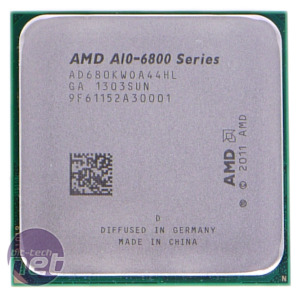
AMD A10-6800K and A10-6700 (Richland) Reviews
Manufacturer: AMDA10-6800K UK price (as reviewed): £114.82 (inc VAT)
A10-6800K US price (as reviewed): $149.99 (ex Tax)
A10-6700 UK price (as reviewed): £114.80 (inc VAT)
A10-6700 US price (as reviewed): $148.99 (ex TAX)
In spite of Nvidia's recent high end GPU launches, AMD's range continues to remain competitive on this front, but its performance CPUs are sadly little match for Intel's, with the recent release of Haswell further cementing the latter company's lead in this arena. Its APUs are a different matter, however, as since the release of Llano, AMD has had a clear lead over Intel when it comes to onboard GPU performance, which Trinity subsequently improved upon. This has made the FM1 and FM2 platforms viable and attractive choices for budget builds where the power of a discrete GPU isn't necessary, with APUs like the A10-5800K offering decent overall performance for a reasonable price. Indeed so compelling is the approach that famously both Microsoft and Sony have chosen AMD APUs to power their next generation consoles.
The recent reveal of AMD's 2013 APU platforms demonstrated that the company is keen to focus much of its efforts on the mobile computing market. Temash, Kabini and the mobile Richland range placed much emphasis on low power consumption and increased performance-per-watt, traits which are somewhat more relevant in the world of notebooks, hybrids and tablets than in that of desktops. It's easy to draw parallels with Haswell here too, as despite its desktop debut, the claimed significant improvements to power efficiency and onboard graphics will mainly be felt as Intel's new architecture finds its way into the mobile space.
Nevertheless, it's fair to say that neither AMD nor Intel has completely neglected desktop users, and today marks the launch of the non-mobile Richland APUs, with five new SKUs being made available immediately. Rather than a significant architectural overhaul, Richland is a relatively minor update to Trinity. As such, the new APUs are all based on socket FM2 and consequently supported by the exciting A-series chipsets, namely A55, A75 and A85x.
Depending on where you look, the price of the new APUs command roughly a 10 or 20 percent price premium over the corresponding Trinity parts, although AMD claims that Richland will sit alongside Trinity in its FM2 range rather than outright replacing it.
Today we're testing the two top models of the range, the A10-6800K and the A10-6700. They can both be found for £110, which makes them around £20 dearer than the Intel Core i3-3220, the most recent budget CPU we've had the opportunity to look at.
| APU Model | A10-6800K | A10-6700 | A8-6600K | A8-6500 | A6-6400K |
| GPU | HD 8670D | HD 8670D | HD 8570D | HD 8570D | HD 8470D |
| TDP | 100W | 65W | 100W | 65W | 65W |
| GPU Cores | 384 | 384 | 256 | 256 | 192 |
| GPU Clock Speed | 844 MHz | 844 MHz | 844 MHz | 800 MHz | 800 MHz |
| CPU Cores | 4 | 4 | 4 | 4 | 2 |
| CPU Clock (Turbo/Base) GHz | 4.4/4.1 | 4.3/3.7 | 4.2/3.9 | 4.1/3.5 | 4.1/3.9 |
| Total L2 Cache | 4MB | 4MB | 4MB | 4MB | 1MB |
| Max DDR3 | 2133 | 1866 | 1866 | 1866 | 1866 |
| AMD Turbo Core | Yes | Yes | Yes | Yes | Yes |
| Unlocked Multiplier | Yes | No | Yes | No | Yes |
| RRP | £116.99 | £116.99 | £91.99 | £91.99 | £57.95 |
At a high level, there's little that's changed between Trinity and Richland, as both sets of desktop APUs are based on Piledriver cores, built with 32nm technology and rated with TDPs of 65-100W. The Radeon 7000 series' onboard graphics component has been newly christened as the Radeon 8000 series, but in this instance both are fundamentally the same thing. As before, the GPU's memory is tied to the system memory, so faster memory kits should mean higher frame rates.
As AMD has stuck with the same 32nm manufacturing process and the same form factor and die size as before, there's quite literally little room for physical improvements. Thus, one of the most obvious areas for increasing performance is that of clock speeds, and indeed both the CPU and GPU clocks have been given a bump. The A10-6800K and A10-6700 have had their GPU clock speed increased by 5.5 percent compared to the A10-5800K and A10-5700, while the base CPU clock has been upped by about 8 and 9 percent respectively. Hopefully these higher clock speeds haven't impacted on the chip's overclocking potential, which you can read about over the page.

MSI MPG Velox 100R Chassis Review
October 14 2021 | 15:04









Want to comment? Please log in.